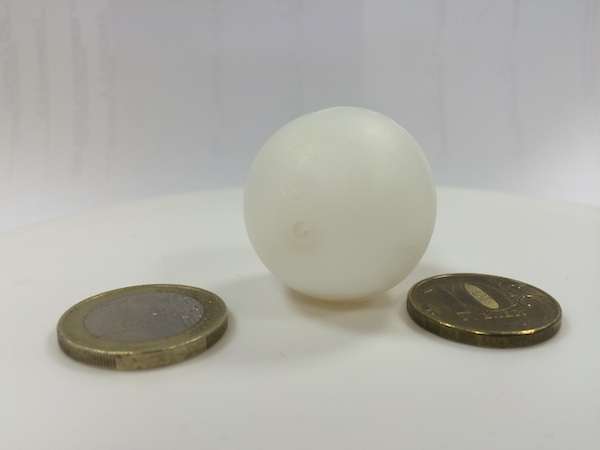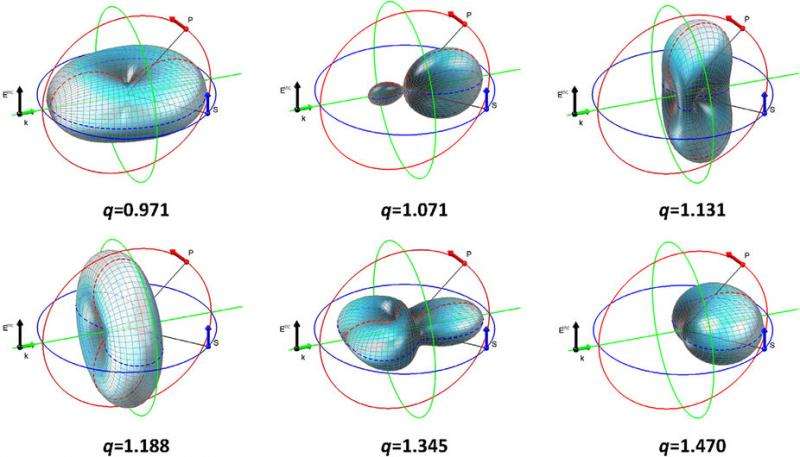Researchers provide experimental foundation for optical computing

Someday, our computers, nanoantennas and other kinds of equipment may operate on the basis of photons rather than electrons. Even now, researchers are preparing to accomplish this technological switch. An international group of Russian, French and Spanish scientists have made a contribution toward the elementary components of new photonic devices. The results of their study have been published in the latest issue of Scientific Reports.
During last four decades, Moore's law, according to which computer's processor speed doubles every 18 months, was reached due to increasing of the operating frequency of a single processor. Now the same result is reached by means of parallel computing—we have dual-core processors as well as quad-core ones. It means that manufacturers can't double the speeds of single-core processors because the operating frequency of modern computer processors is close to the theoretical limit. Multiplying the number of cores is also not a long-term solution; by all accounts, it will soon reach its limit, as well. That's why research teams all around the world are working toward the creation of super-fast optical systems, which would be able to replace electronic computers.
On one hand, such systems should be as small as possible. On the other hand, optical radiation has its own scale—the wavelength (in the visible range of the spectrum it is about 0.5 micrometers). This scale is too big to be implemented in modern electronic devices with ultra-dense arrangements of elements. In order to compete with such electronic devices, optical systems should work on scales much shorter than the wavelengths. These problems fall within the domain of a modern discipline called subwavelength optics. The aim of subwavelength optics is to manipulate electromagnetic radiation on scales shorter than its wavelength—in other words, to do the things that are considered to be conceptually impossible in the traditional optics of lenses and mirrors.
Until recently, subwavelength optics researchers explored effects related to interactions of light with so-called plasmons—collective oscillations of free electron gas in metals. In the case of metal particles with sizes around 10 nm, the oscillation frequencies of the free electron gas fall within the range of the optical band. If such a particle is irradiated with an electromagnetic wave whose frequency is equal to one of the particle's plasmon oscillation frequencies, a resonance occurs. At the resonance, the particle acts as a funnel, which "grabs" the electromagnetic wave's energy from the external environment and converts it into the energy of the electronic gas oscillations. This process can be accompanied with a wide range of interesting effects that, in principle, could be employed in various applications.

Unfortunately, plasmonics has not met these expectations. The fact is that even very good electric conductors (for example, copper or platinum) exhibit significant electric resistance when the frequency of the electric current reaches the same order of magnitude as that of visible light. Therefore, as a rule, the plasmon oscillations are strongly damped, and the damping kills the computationally useful effects.
Recently, scientists turned their attention to dielectric materials with high refractive index. There are no free electrons in these materials because they are all bound to their atoms and the impact of light does not induce conduction current. At the same time, electromagnetic waves affect atoms' electrons and shift them from their equilibrium. As a result, atoms acquire induced electric moment; this process is called polarization. The higher the degree of polarization is, the higher the refractive index of the material. It turns out that when a sphere made of a material with high refraction index interacts with light, the result of this interaction to a large extent resembles the above-described plasmon resonance in metals with one very important exception: A wide range of dielectric materials—as distinct from metals—have weak damping at the optical frequencies. We often use this property of dielectrics in our everyday life—for example, weak damping at the optical frequencies is the key for the transparency of glass.
Old research by Professor Michael Tribelsky of the Faculty of Physics, M.V. Lomonosov Moscow State University, inspired the recent research described above. The scientist says, "If we relate the language of quantum physics to plasmon excitation, we can say that a quantum of light, a photon, is converted into a quantum of plasmon oscillations. I had the following idea: Since all processes in quantum mechanics are reversible, the inverted process of the plasmon-to-photon conversion should also be possible. Then I arrived at the conclusion that a new type of light scattering exists. This was, indeed, the case. Moreover, it occurred to me that this new type of light scattering has very little in common with that described in all textbooks, Rayleigh scattering."
As a result, paper "Resonant scattering of light by small particles," was published in 1984. However, this work did not attract the attention of scientists, because nanotechnologies did not yet exist. The first citation of this paper occurred in 2004—exactly 20 years after its publication. Nowadays, this type of scattering, called "anomalous," is widely acknowledged. Unfortunately, even in the case of anomalous scattering, application confronts the fatal role of dissipation. In order to observe anomalous scattering, it is necessary to use metals with very weak damping at optical frequencies.
The very natural question in this case is: If we take advantage of the weak damping of dielectrics, will a sphere made of dielectric materials with a high refraction index demonstrate the effects that cannot be observed in plasmon resonances in metals with strong damping? To answer the question, Professor Tribelsky's laboratory carried out a joint research project with French and Spanish colleagues. Scientists experimented with a dielectric sphere with a diameter about 2 cm made of special ceramics, and used it to redirect the incident electromagnetic waves in a desired manner. Moreover, the directionality of the scattering may be controlled and changed dramatically just by fine tuning of the frequency of the incident wave.
According to Tribelsky's explanation, this sphere has rather narrow resonance lines related to its polarization oscillations. In a sense, it is quite analogous to a metal sphere, which has the resonance frequencies related to the oscillations of the free electron gas. Every line corresponds to the excitation of a particular oscillation mode, called harmonics, or partial modes. Every harmonic is characterized by a fixed dependence between the scattering intensity and the scattering angle. This dependence is determined by the nature of a given harmonic. The sphere's total scattering field is a sum of the contributions of every harmonic (partial wave). Partial waves interfere with each other. The narrow width of these lines allows partial modes to be selectively excited and to control the interference. This, in turn, allows redirecting the incident radiation in a desired way. Thus, the controlled manipulation with the radiation is achieved.
However, why do we speak about nanoscales if the sphere's diameter is about 2 cm? That's just the point. Prof. Tribelsky says, "I can freely speak about the experimental beauty of this work as I'm a theoretician. I just participated in the planning of the experiment, while the entire difficult experimental work was done by my French colleagues. The experimental beauty of this work lies in the following: With the help of the microwave radiation—similar to that used in a mini oven—we have managed to simulate on a centimeter scale all the processes that occur on a nanoscale with visible light. It is widely known that if we have two objects of the same shape but of different sizes and with the same refractive index, they will scatter the electromagnetic waves in the same way, provided the ratio of objects' linear dimensions to the wavelength is the same for both the objects. This was the basis of our experiments. However, the path from the idea to the results was very difficult. Suffice to say that the researchers managed to separate the desired signal from background whose amplitude sometimes was 3000 times larger than that of the signal."
Bearing in mind possible practical applications of the obtained results, it is important to stress that the fabrication technique of such nanospheres for manipulation of optical and near-infrared radiation is cheap and simple. It does not require any exotic or expensive materials, or any sophisticated equipment. Besides optical computers (which, nowadays, remain in the sphere of theoretical), nanoscale spheres described in the paper by Tribelsky and co-authors have a wide range of applications: telecommunication systems, recording, processing and storing of information, diagnosis and treatment of different diseases, and many others.
More information: "Small Dielectric Spheres with High Refractive Index as New Multifunctional Elements for Optical Devices" Scientific Reports 5, Article number: 12288 (2015) DOI: 10.1038/srep12288
"Resonant scattering of light by small particles," Tribel'skii M.I., Sov. Phys. JETP 59[2], 534 (1984): www.jetp.ac.ru/cgi-bin/dn/e_059_03_0534.pdf
Journal information: Scientific Reports
Provided by Lomonosov Moscow State University



















